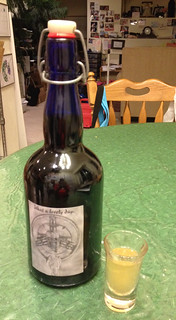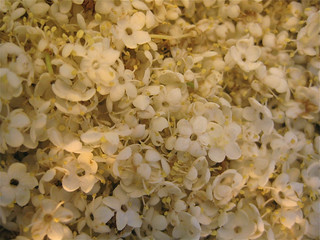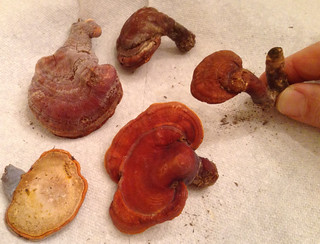Maple sugar/syrup is easy to make and is a wonderful source of stable, storable calories. You can collect the sap from any maple tree (not just sugar maples) in any part of the world if you know what you are doing.
First, a little plant biochemistry. The sugar in maple sap is used by the tree as building blocks for making new leaves. This means the sugary sap starts flowing in late winter when the tree starts making the leaf buds. Up north, the tree "wakes up" and begins pumping sap up to its branches when nights are still below freezing but daytime highs are in the mid-40s. This is when you need to tap your tree. In southern climates knowing when the sap flows is trickier. I suggest you drill a 1/4" hole into your tree at a slight upwards angle 3" into the tree on New Year's Day and then watch for sap to begin leaking out. Drill this hole on the south (warmest) side of the tree about 3 feet off the ground, just as you would place a tap (aka "spile"). I wouldn't put a tube or anything in it other than maybe a cotton ball that had been treated with the bleach solution. Just keep an eye on the hole and see if it starts weeping.
Traditional maple tree taps are called spiles and can be ordered on-line from various sources. You can also make your own spiles from PVC tubing, Tygon tubing, plastic pen bodies, hollowed-out pieces of elderberry, bamboo, etc. Just make sure the hole you drill will hold the spile tightly. If the hole is too big you can pack the opening with softened wax. The spile should be cut at an angle with the longer part of the spile up against the top of the hole. Sap flows into the hole from the bottom (duh), so you don't want to plug the bottom of the hole. Sterilized soda bottles make great collectors as the small top keeps crap out of the sap. Traditional sap buckets have hinged cover to do the same thing (crap protection).
You need a maple tree at least 12" in diameter to tap. Drill the tap hole(s) on the south-facing side of the tree about three feet off the ground. If the tree is more than 20 inches in diameter you can add a second spile, and if it's greater than 27 inches you can have three spiles. The tap holes are drilled 3 inches deep at a slight upward angle. Spiles will be either 5/16 inches or 7/16 inches in diameter, so use the corresponding drill bit. Pound the spile into the hole and hang your bucket from the little notch on the spile.
IMPORTANT: Wash all your drill bits and spiles with a bleach solution before they enter the tree to avoid infecting the tree with fungus or bacteria! Use a 1:10 bleach to water solution (example: 1 teaspoon bleach in 9 teaspoons of water). Let any plug-dowel soak in freshly-made bleach solution for about 15 minutes before inserting it into the hole. Soak-time for spiles and drill bits ranges from 2-3 minutes for metal or plastic objects up to 15 minutes for porous materials. Some people spray this solution on the tree just before tapping but I have a bit more faith in the strength of trees than that.
Sap will run 4-6 weeks, but the sweetest, most sugar-filled sap will be at the beginning. Check your buckets and collect the sap every day at first as the sap will really be flowing and this will keep non-sap stuff out of the buckets. By the fifth week all the sugar that had been stored in the roots has been transferred up into the new leaf buds. Remove the spile, disinfect the tap hole, then place a bleach-treated wooden dowel in the hole.
It takes about 10 gallons of sap to make one quart of syrup, or a 40-to-1 sap/syrup ratio. Boiling it down releases a LOT of water vapor so it is best done outside. Side story: one year my dad decided to boil off the water using the stove inside the house. Mom was out of town that day. Dad boiled off approximately 50 gallons of sap which caused all the wallpaper in our house to peel. When mom got home she was pretty upset.
It's best to evaporate most of the water over a wood fire outside using a big pot. Pure water boils at 212F, finished syrup boils at 219F. Keep track of the temperature with a large candy thermometer. Once you've driven off enough water outside over the fire to raise the boiling temperature to 216F you can take it inside and finish it off over the more controlled heat of your stove. Transfer the fluid to a smaller pot, filtering it through some cheese cloth if there are solids present. Once it reaches 219F transfer the hot syrup to clean (sterilized by boiling) jars.
This syrup will stay good as-is for about two months and if frozen for up to a year. For longer-term storage it is best to reduce it down to maple sugar. To do this carefully keep boiling the syrup to drive away the rest of the water. You want the temperature of the boiling sugar to be between 290F and 300F. It will want to foam over and if it does remove the pan from the heat until the sugar/syrup settles down, then return it to the heat. Traditionally, the boiling sugar (290-300F) is transferred to a wooden bowl and stirred with a wood spoon to remove the last bit of moisture. It will harden into a solid mass as it cools. This mass is broken off the spoon and out of the bowl and stored in an airtight container. When sugar is needed use a heavy-duty cheese grater to grate off what you need.
Buy my book! Outdoor Adventure Guides Foraging covers 70 of North America's tastiest and easy to find wild edibles shown with the same big pictures as here on the Foraging Texas website.






